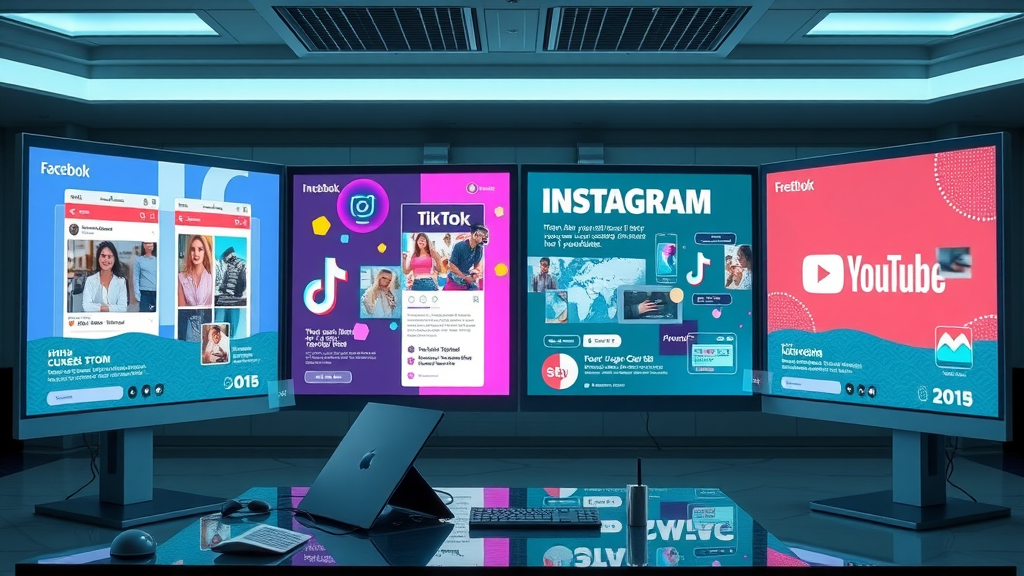Did you know that over 4.8 billion people worldwide use social media—equating to nearly 60% of our planet's population? This digital revolution presents groundbreaking possibilities for reaching your audience more efficiently than ever before. In this comprehensive guide, we’ll pull back the curtain on how social media advertising enables modern brands—small and large—to secure massive reach, drive tangible results, and future-proof their marketing. If you’re ready to unlock the potential of media ads and master campaign excellence in the digital age, keep reading!
Shocking Growth: Why Social Media Advertising Is the Futurist's Edge

- Discover recent statistics proving exponential growth and relevance of social media advertising: Recent studies show that global spending on social media ads surpassed $230 billion in 2023 and is projected to increase by 20% annually for the foreseeable future. Platforms like Facebook, Instagram, TikTok, LinkedIn, and YouTube are not just communication tools—they're media platforms reshaping how businesses connect with buyers. These skyrocketing numbers highlight the shift to digital-first strategies, making social media advertising indispensable for attaining brand awareness and crossover sales in any industry.
- Uncover how businesses of all sizes achieve massive reach using targeted social media ad strategies: Previously, only industry giants could afford prime media advertising spots. Today, businesses of every size—boutiques to global corporations—leverage media ads for pinpoint audience targeting. Small retailers expand into global e-commerce, while service providers generate leads on a local and national scale. Done right, a data-driven social media ad can outperformance traditional marketing with a fraction of the investment.
Unlocking Social Media Advertising: Definition, Benefits, and Core Concepts
- Clear definition and evolving landscape of social media advertising: Social media advertising refers to the use of paid advertisements on platforms like Facebook, Instagram, LinkedIn, TikTok, and YouTube to reach highly specific, intent-driven audiences. Unlike conventional media advertising, which targets broad demographics, this approach enables personalized message delivery across the ever-evolving landscape of digital media marketing .

- Core benefits: precision targeting, scalable reach, and engagement: Social media ad platforms offer advanced targeting options —demographics, interests, behaviors, lookalike audiences—ensuring your product or service reaches users most likely to convert. The scalability is unmatched: campaigns can start with minimal budgets and ramp up instantly. Engagement metrics such as shares, likes, and comments turn simple ads into viral phenomena, compounding results and gathering valuable user data for ongoing optimization .
- How social networks and media platforms play pivotal roles: Every social network and media platform brings unique advantages. Facebook’s robust targeting and analytics make it the go-to for all industries, while YouTube’s video ad formats fuel visual storytelling. LinkedIn is invaluable for B2B leads, Instagram shines for rich visuals, and TikTok’s algorithm offers viral exposure. Their collective innovation ensures the advertising landscape will keep evolving, offering fresh features and audience expansion opportunities for marketers ready to adapt.
What You'll Gain From Mastering Social Media Advertising
- Actionable strategies to maximize media advertising ROI: Learn how to allocate budget across platforms, use split-testing to improve performance, and retarget warm audiences for greater efficiency. Mastering these strategies means turning ad spend into measurable results.
- Insight into the best social media platforms for your brand: Not all platforms are created equal. Discover which channels align with your brand’s voice, visuals, and audience demographics to drive the most engagement and conversions.
- Master targeting audiences and ad creative development: You will unlock the secrets to identifying your ideal target audience , developing creative and compelling ad copy, and leveraging generated content for higher authenticity and connection—all crucial for campaign success.

Top Social Media Platforms for Advertising Campaigns
Choosing the Right Social Media Platform for Your Social Media Ad
- Compare Facebook ad and Instagram ad functionalities: A facebook ad offers granular targeting and multiple ad formats, including carousel and video, making it suitable for diverse business objectives. An instagram ad shines with visually captivating stories, shopping integrations, and direct purchases, ideal for brands focused on aesthetics and lifestyle.
- Explore unique opportunities in Youtube ad and Tiktok ad formats: A youtube ad can drive deep narrative engagement through skippable and non-skippable video ad formats, while a tiktok ad harnesses viral trends, music, and creative challenges to capture the fleeting attention of Gen Z and Millennials like no other media ad.

- Linkedin ad and professional targeting strategies: LinkedIn’s sophisticated ad platform lets you target by industry, seniority, company size, and more, making it unrivaled for B2B services and recruitment campaigns. Using a linkedin ad , your brand message reaches decision-makers in a professional context, driving high-value leads and business partnerships.
| Platform | Primary Audience | Top Ad Formats | Strengths |
|---|---|---|---|
| 25-54, diverse backgrounds | Carousel, video, lead forms, stories | Advanced targeting, robust analytics, huge reach | |
| 18-34, style-conscious, visual | Stories, reels, shopping, photo | Visual storytelling, influencer synergy | |
| YouTube | 15-49, broad | Skippable/non-skippable video, in-feed ads | Video engagement, long-form content |
| TikTok | 16-35, trend-driven, creative | In-feed, branded hashtags, TopView, challenges | Viral potential, user participation |
| 25-55, professionals, B2B | Sponsored content, InMail, lead gen forms | B2B targeting, professional setting |
Crafting Winning Social Media Advertising Campaigns
Define Clear Objectives and Target Audiences
- Step-by-step process for social media ad targeting: Begin by sharpening your ad’s objective—brand awareness, website traffic, lead generation, or sales—then select your target audience using detailed criteria: demographics, location, interests, behaviors, and lookalike segments. Platforms like Facebook and LinkedIn offer built-in tools to refine these characteristics, ensuring you reach the users most likely to engage with your content.
- Align ad creative with target audience interests: Once your audience is defined, develop ad creative that mirrors their preferences. For instance, tech brands can feature behind-the-scenes or explainer videos, while lifestyle brands succeed with striking images or stories. A/B test creative variations to optimize for click-throughs, conversions, and engagement, refining your strategy based on real-time data.

The Power of Ad Creative: Visuals, Copy, and User-Generated Content
- Tips for compelling media ad creative across platforms: To capture attention in users’ busy feeds, use high-contrast visuals, concise copy, and clear calls-to-action. Experiment with video ad formats, carousel stories, and bold color schemes tailored to each social media platform . Authenticity is key—content that feels genuine outperforms overly polished ads.
- How to leverage generated content for authentic engagement: Showcase user-generated content such as customer testimonials, unboxings, and reviews to create social proof. Encourage your audience to tag or mention your product or service , amplifying trust and organic reach. UGC campaigns often outperform traditional advertising campaign tactics, as today’s audiences value real feedback.
“Content is fire. Social media is gasoline.” — Jay Baer

Media Advertising Strategies for Maximum Reach and Engagement
- Audience segmentation in social media ads: Use custom and lookalike audiences to segment by purchasing behavior, engagement patterns, and demographics. This boosts relevance and efficiency of your social ad, focusing spend where it’s most likely to convert.
- Utilize media ads for retargeting and cross-platform synergy: Retarget website visitors and previous customers across multiple media platforms to maintain top-of-mind presence and increase conversion rates. Cross-platform campaigns extend your reach, reinforcing your message to users wherever they browse or scroll.
- Enhance your advertising campaign with data-driven optimization: Monitor metrics such as CTR, CPM, and conversion rates to iterate on creative, placements, and budgets. Platforms like Facebook and Google provide granular insights, ensuring your campaigns get smarter and more effective with each iteration.
The 5 5 5 Rule and 50/30/20 Rule in Social Media Advertising
Understanding the 5 5 5 Rule for Social Network Engagement
- Practical breakdown of content mix and frequency: The 5 5 5 rule recommends posting five different types of content (such as promotions, behind the scenes, testimonials, educational tips, and user stories), five times a week, while engaging with at least five users or brands daily. This approach maximizes interaction and builds a well-rounded presence on every social network , increasing visibility and building authentic relationships through your media ad content rotation.

Applying the 50/30/20 Rule for Balanced Advertising Content
- Guidance for maintaining effective media advertising balance: The 50/30/20 rule is your formula for a content mix: allocate 50% to informing or educating your audience, 30% to sharing valuable third-party or curated content, and 20% to promotions. This strategy keeps your media ads fresh and your audience engaged—striking the right balance between providing value and marketing your product or service.
Case Studies: Social Media Advertising Success Stories
- Instagram ads that fueled e-commerce growth: A small fashion retailer adopted a targeted instagram ad strategy, using shoppable posts and influencer partnerships. Their daily site traffic tripled, and monthly sales soared by 60% within a quarter, thanks to strategic audience segmentation and visual storytelling.
- Facebook ads driving brand awareness for startups: A tech startup seeking B2B visibility ran a series of lead-generating facebook ads with compelling video ad content and whitepaper downloads. The campaigns doubled their lead pipeline, halved acquisition costs, and solidified their brand awareness in a competitive industry.
- TikTok ads and viral campaign impact: An emerging beverage brand used tiktok ads centered on branded hashtag challenges and micro-influencer collaborations. The result was a viral sensation—over 5 million video views, a 400% spike in social following, and shelves emptied faster than ever before. These examples show that creative, data-driven social media advertising can yield truly game-changing results for all business sizes.

“Our Facebook campaign halved costs and tripled conversions.” — Real Success Story
Best Practices for Social Media Advertising ROI
- Tips for analyzing and optimizing your media advertising: Regularly audit your ad creative, update audiences, and pause underperforming ads. Leverage A/B testing to find top-performing content, and use data visualization dashboards for quick insights. Ad platforms reward relevancy—so the better you optimize, the lower your costs and higher your results.

- Essential metrics: CPM (cost per mille), CPC (cost per click), CTR (click-through rate), and engagement rate: Use these benchmarks to track ad spend efficiency and campaign performance. High engagement rates reflect content resonance, while low CPM and CPC mean your ads are cost-effective.
- Set clear, measurable goals for each media advertising campaign
- Research and segment your target audience for every platform
- Design scroll-stopping visuals and concise messaging
- Incorporate user-generated content and reviews
- Test different formats (carousel, stories, video ad, static)
- Monitor metrics daily and optimize based on insights
- Refresh your ad creative every 2–4 weeks for top performance
FAQs: Navigating the World of Social Media Advertising
-
How often should I refresh my ad creative?
It’s recommended to update your ad creative every two to four weeks. This prevents ad fatigue, keeps your target audience engaged, and enables you to incorporate trends, seasonal offers, or feedback from KPIs for ongoing campaign improvements. -
Does user-generated content improve media ad performance?
Yes, user-generated content boosts authenticity and credibility, providing social proof that resonates with consumers. Campaigns leveraging user content achieve higher engagement rates and lower acquisition costs compared to purely branded media ads.

-
What is the impact of influencer partnerships on advertising campaign ROI?
Influencer partnerships can dramatically increase the ROI of a social media advertising campaign. Influencers expand your organic reach, add credibility, and create new opportunities for viral content, often outperforming traditional sponsored posts in terms of cost-effective conversions and engagement.
People Also Ask: Key Questions on Social Media Advertising
What is the social media advertising?
- Social media advertising refers to paid marketing efforts on platforms such as Facebook, Instagram, LinkedIn, TikTok, and YouTube designed to reach targeted audiences effectively and enhance conversions or brand awareness. It leverages data-driven strategies and platform features for scalable, measurable growth.
What is the 5 5 5 rule on social media?
- The 5 5 5 rule suggests posting five types of content, five times a week, and engaging with at least five different users or brands, ensuring a well-rounded content approach and higher engagement in social media advertising.
What is the 50/30/20 rule for social media?
- The 50/30/20 rule recommends splitting your content: 50% informs/educates, 30% shares from others (curated content), and 20% promotes your brand or product, keeping social media ad strategies authentic and user-focused.
How effective are social media ads?
- Social media ads are highly effective, offering precise targeting, real-time data analysis, and scalability, often outperforming traditional media advertising in reach, engagement, and ROI.
Watch: Social Media Advertising Explained (Video Guide)
Watch our high-quality video explaining key social media advertising concepts, campaign strategies, and how to visualize analytics for best results.
Key Takeaways for Strategic Social Media Advertising Success

- Identify your target audience and choose the ideal social media platform
- Invest in compelling ad creative and user-generated content
- Monitor campaign metrics and optimize regularly for lasting results
Connect With Experts for Powerful Social Media Advertising Solutions
- Call us at (385) 469-1869 or email at info@solu4u.com today to start your journey to unmatched online reach and a thriving advertising campaign!
Commit to mastering digital trends, monitor your analytics weekly, and innovate your social ad creative every month to maximize your next advertising campaign’s ROI.
Sources
- https://sproutsocial.com/insights/social-media-advertising-statistics/
- https://www.hootsuite.com/resources/social-media-advertising
- https://buffer.com/library/social-media-advertising/
- https://www.wordstream.com/social-media-advertising
- https://www.statista.com/topics/1538/social-media-usage-worldwide/
To deepen your understanding of social media advertising, consider exploring the following resources:
- “Social Media Advertising: Definition, Types, and Benefits” ( adroll.com )
This article provides a comprehensive overview of social media advertising, detailing various ad formats and their advantages.
- “Social Media Marketing: Strategies, Tips, and Essentials” ( socialinsider.io )
This resource offers actionable strategies and tips to enhance your social media marketing efforts, emphasizing content diversity and audience engagement.
By delving into these articles, you’ll gain valuable insights to refine your social media advertising strategies and achieve better results.
 Add Row
Add Row  Add
Add 




Write A Comment